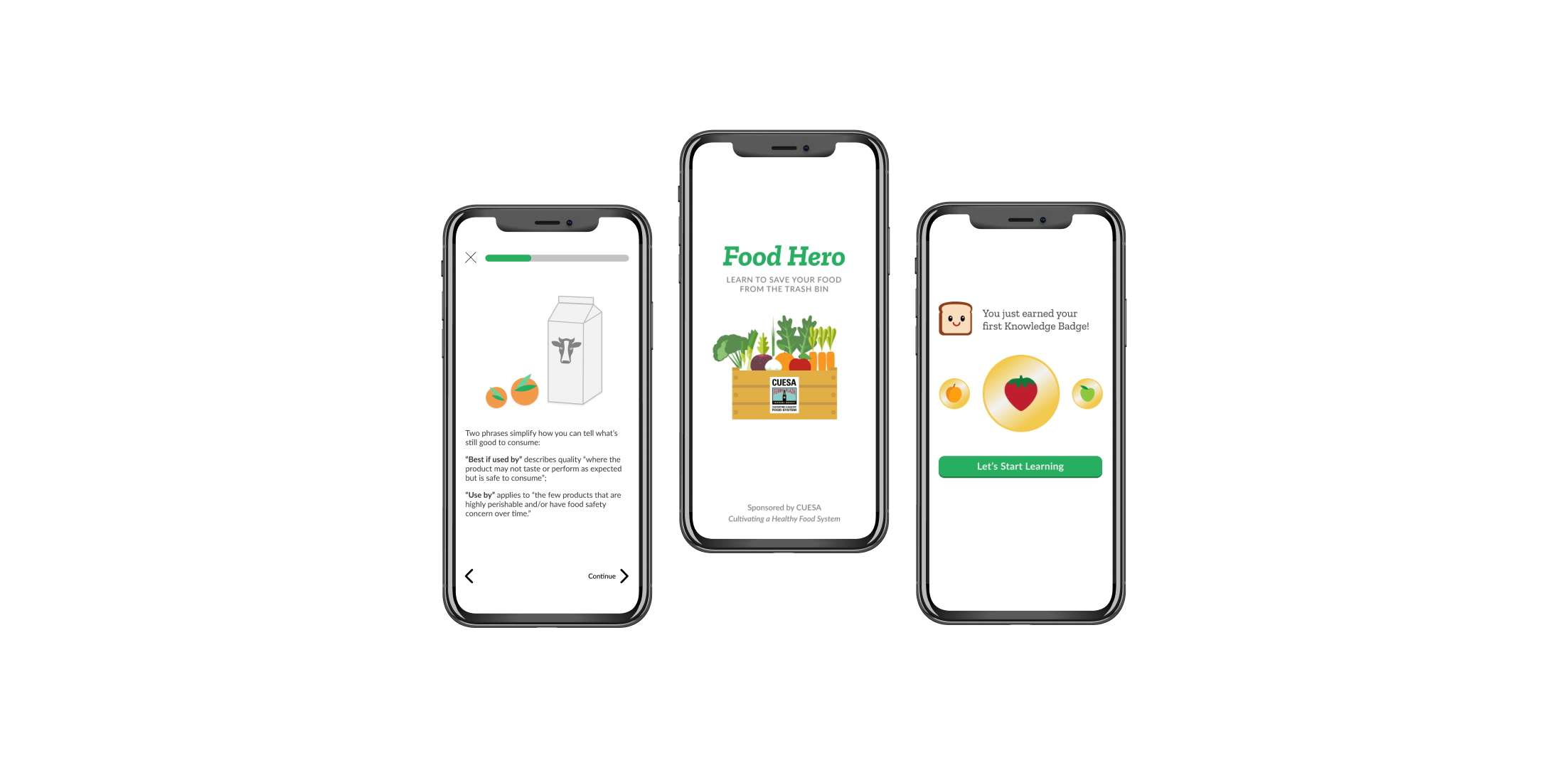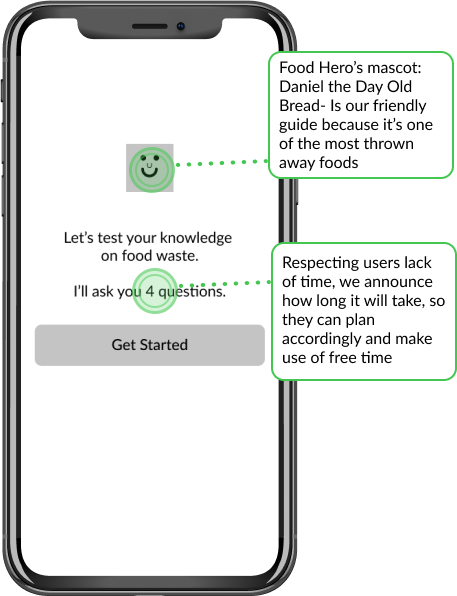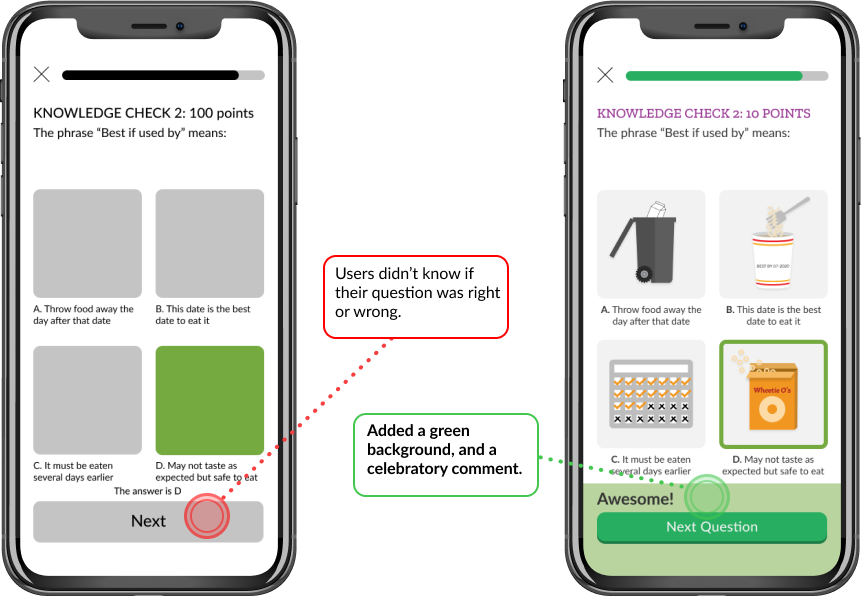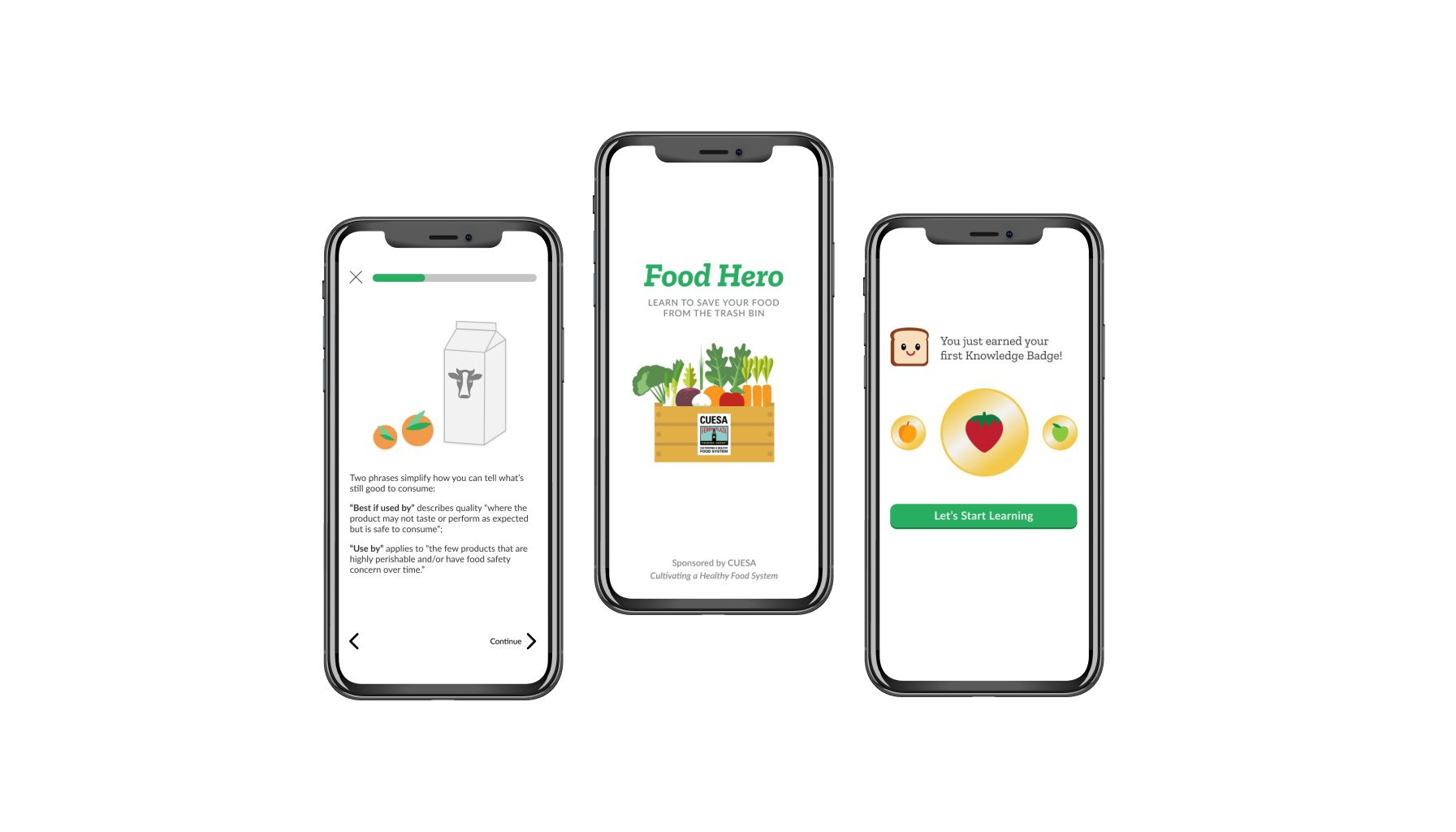
Food Hero
Food Sustainability App for Cuesa
Project Details
Timeline 2-week sprint
Platform iOS
Contributing Members Colleen McHale, Monica Lee
My Contributions Synthesis Lead, 6 User Interviews & Synthesis, Empathy Map, Competitive Analysis, Assisted Design Lead, High Fidelity Design
Tools Figma, Miro, Zoom, Pen & Paper
About CUESA
CUESA (c-whey-sa) is known for managing world class farmers markets in the San Francisco area and providing the public access to local high-quality products. Their mission is focused on sustainability, excellence, vision, and community; driving CUESA towards education, advocacy, and action for a sustainable food system.
Design Challenge
Use technology to engage and educate the public on food sustainability, and how to reduce food waste.
Exploring the Problem
CUESA believes food waste is a critical part of a sustainable food system, but the small section they have on their website dedicated to food waste articles and resources hasn’t propelled people into action. They want to explore the role that technology can play in engagement and innovation of keeping food waste out of landfills.
C & C
When evaluating sites similar to CUESAs I found many that shared the similar issues. However, one site had clear navigation to resources, meal planning, and recipes. I also looked at mobile applications. While websites were plentiful, there weren’t food waste specific apps. Since we were looking to educate the general population, I also looked at the learning app, Duolingo. It teaches and engages users through its quizzes, and reward system.
Interviews
With this information in mind, I conducted interviews, to see how people feel about sustainability and why. I screened for people who were interested in food sustainability and regularly shopped for groceries. I asked questions about:
How people prevent food from spoiling
What people do when food spoils
What I found:
People liked to be “green” for the feeling of helping out their community and the environment.
People recycled and were more green when it was something easy to do.
People whose city provided compost bins, outlawed single use bags or straws, were more likely to stick with a green habit.
People who aren’t already very “green” don’t know where to start and what to do.
Solving the Problem
Persona
After our interviews, I crafted our Persona: Bella. She represents the common behaviors, habits, needs, and frustrations I found in user interviews. Bella was useful to our team because she gave a point to focus on. Anytime I was unsure if we should include or remove a feature, I would look to Bella’s frustrations and goals.
I formulated questions to address CUESAs need for engaging and informing the public; Bella’s needs for ease, convenience, love of learning; and what other like-sites do. These questions were:
How might we educate Bella about how to further help the environment?
How might we educate and assist Bella in preventing food waste in the first place?
Our resulting answer:
By providing Bella with an interactive way to educate herself on food storage, meal planning & recipes, we will help her become more personally engaged in helping the environment.
Experience Map
I came up with a theoretical task for Bella to test the solution before moving forward. This provides us a direct way to see the app through the eyes of Bella. Because Bella isn’t an actual person, I step in and think in her stead, letting me take a step back and view the overall possible interaction. How would she perceive the app, what feelings, thoughts, and experiences might she might have? The task for Bella was: after throwing away food again, Bella would download the app and move through it, taking lessons, completing quizzes, and reading articles. In the end she left the site happy for having learned something new.
Our research and ideas came together in these grayscale wireframes.
Testing the Solution
After doing a theoretical test with Bella, we moved on to testing with actual potential users. We tested with four people, looking for major flaws or any inconsistencies in the workflow. We measured time to completion, clicks, observations, and comments from users.
What we found was:
Users were excited to get questions right, and disappointed to get them wrong.
Users found it difficult to know if their question was right or wrong.
Users went directly to the search function instead of navigation buttons.
Users were unsure what the points were for.
Style Guide
Because CUESAs brand is down to earth, authentic, warm, welcoming, optimistic and practical, we wanted to be sure to keep its identity intact while designing. We put together this style guide.
Final Product
With the problem areas fixed, we were ready to move into high fidelity wireframes, adding colors and images. I focused on making everything easy to use: information is provided in a variety of formats for easy learning and tasks are quick so Bella can have time to complete them while doing other tasks. Best of all, she’s closer everyday to being sustainable.
Next Steps
The next steps for CUESA to continue on its journey of sustainability, excellence, vision, and community are:
Research how much information people can retain from our articles and lessons to see if they should be shortened or designed in a new way for better retainment
Research whether or not people are actually putting their new knowledge to use
Implement push notifications: give gentle reminders to the users about sustainability and the app resources
Add a favorites option: give users the ability to save their favorite articles and quickly find them again
Share to social media: allow users to share articles with friends and followers
Lessons Learned
Evaluating our persona was a challenge. After synthesizing the interview data I found 2 distinct groups interested in food sustainability. This formed Bella and Sarah. Sarah is fully committed to sustainability. She already follows proper “green” steps-going the extra mile. What would Sarah need? We analyzed CUESAs vision again: to engage and educate the public on food sustainability, and how to reduce food waste. Because Sarah is already engaged and educated in food waste and sustainability, she isn’t CUESAs target market. While in hindsight it wasn’t necessary to have interviewed some of our candidates, Sarah helped us to evaluate who we weren’t creating for.
















